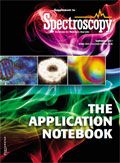IC-ICP-MS Speciation Analysis of As in Organic Brown Rice Syrup (OBRS)
This paper demonstrates an ICP-MS method for the determination of total and As species concentrations in organic brown rice samples (OBRS).
This paper demonstrates an ICP-MS method for the determination of total and As species concentrations in organic brown rice samples (OBRS).
A US report on high As levels in OBRS (1) (an organic food ingredient) has increased interest from consumer groups, politicians and regulatory bodies (2) in the determination of As in foodstuffs.
In this study, OBRS samples were analyzed for total As by ICP-MS and then by IC-ICP-MS to determine the concentration of six As species: two toxic inorganic species (As [III] and As [V], and four organic species that are considered to be harmless).
Instrument configuration
All measurements — total As and As speciation — were carried out using the Thermo Scientific iCAP Qc ICP-MS. All As analyses were performed in He kinetic energy discrimination (KED) mode to minimize polyatomic interferences for the analysis of (monoisotopic) arsenic. Chromatographic separations were carried out using the Thermo Scientific Dionex ICS-5000 ion chromatography system coupled with the iCAP™ Q ICP-MS which was used as a highly sensitive and selective arsenic detector.
Sample Preparation
Three different OBRS samples were prepared for analysis. For total As analysis, a closed microwave digestion method was used (1).Preparation of the samples for speciation analysis was achieved by taking 1.5 g of OBRS, adding 15 mL of 0.28 M HNO3 and refluxing for 90 min (3).
Results
After external calibration, the total As concentration of the samples was determined.

Table I: Results from the total As analysis of three OBRS samples and analytical figures of merit
As can be seen in Table I, total As concentrations of >100 ng/g were found in the three samples analyzed. As these concentrations may be cause for concern, the samples were analyzed by IC-ICP-MS to determine whether As is present in a toxic or rather harmless species. The resulting chromatogram (Figure 1) shows, that the toxic As (III) is the predominant species found in OBRS.

Figure 1: IC-ICP-MS chromatogram of arsenic species found in one of the OBRS samples.
Conclusion
An ICP-MS method for the quantification of total arsenic and six arsenic species (by IC-ICP-MS) in organic brown rice syrup (OBRS) has been demonstrated. Total arsenic concentrations of between 107–136 ng/g were found in the three samples analyzed. IC-ICP-MS speciation analysis showed that the predominant As species found was the toxic inorganic As (III) with over 80% of the total arsenic concentration (equivalent to 86–109 ng/g As [III]).
References
(1) B.P. Jackson et al., Arsenic, Organic Foods, and Brown Rice Syrup, Environmental Health Perspectives (2012) http://dx.doi.org/10.1289/ehp.1104619.
(2) FDA Statement on Arsenic in Brown Rice Syrup, February 2012: http://www.fda.gov/Food/FoodSafety/FoodContaminantsAdulteration/Metals/ucm292531.htm.
(3) Huang et al.,Quantitative chemical extraction for arsenic speciation in rice grains, J. Anal. At. Spectrom. 25, 800–802 (2010). DOI: 10.1039/C002306.
Thermo Fisher Scientific
Hanna-Kunath-Str. 11, Bremen, D-28199, Germany
tel. (800) 532-4752, fax: (608) 273-5046
Website: www.thermoscientific.com

Newsletter
Get essential updates on the latest spectroscopy technologies, regulatory standards, and best practices—subscribe today to Spectroscopy.
Specificity and the Net Analyte Signal in Full-Spectrum Analysis
July 21st 2025This tutorial addresses the critical issue of analyte specificity in multivariate spectroscopy using the concept of Net Analyte Signal (NAS). NAS allows chemometricians to isolate the portion of the signal that is unique to the analyte of interest, thereby enhancing model interpretability and robustness in the presence of interfering species. While this tutorial introduces the foundational concepts for beginners, it also includes selected advanced topics to bridge toward expert-level applications and future research. The tutorial covers the mathematical foundation of NAS, its application in regression models like partial least squares (PLS), and emerging methods to optimize specificity and variable selection. Applications in pharmaceuticals, clinical diagnostics, and industrial process control are also discussed.
New Study Expands Nickel Autoionization Spectra to Advance Laser Isotope Separation Technologies
July 17th 2025Researchers at China’s National Key Laboratory have identified 170 nickel autoionization states using resonance ionization mass spectrometry, significantly advancing the spectral database critical for laser isotope separation and atomic spectroscopy.
AI-Powered Fusion Model Improves Detection of Microplastics in the Atmosphere
July 17th 2025Researchers from Nanjing University of Information Science & Technology have introduced a breakthrough AI-enhanced multimodal strategy for real-time detection of polyamide microplastics contaminated with heavy metals.
How Analytical Chemists Are Navigating DOGE-Driven Funding Cuts
July 14th 2025DOGE-related federal funding cuts have sharply reduced salaries, lab budgets, and graduate support in academia. Researchers view the politically driven shifts in priorities as part of recurring systemic issues in U.S. science funding during administrative transitions. The impact on Federal laboratories has varied, with some seeing immediate effects and others experiencing more gradual effects. In general, there is rising uncertainty over future appropriations. Sustainable recovery may require structural reforms, leaner administration, and stronger industry-academia collaboration. New commentary underscores similar challenges, noting scaled-back graduate admissions, spending freezes, and a pervasive sense of overwhelming stress among faculty, students, and staff. This article addresses these issues for the analytical chemistry community.